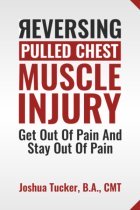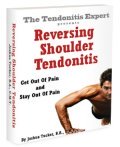Recurring pectoral/chest strain/tear
by Richard
(Sweden)

Area where it hurts the most is marked with a black circle
Hello Joshua.
I got a bad strain/minor tear(not sure what to call it) in my pec a few years ago during a chest workout, i took it easy for a while while doing really light training and some massage, but recovery was really slow and i reinjured it again(probarbly went abit too heavy too fast, even if i wasnt using alot of weight compared to before the injury), so i found this site and contacted you.
I did the ice massage treatment several times a day for a few weeks followed by lighther training while increasing the resistance very slowly over a longer period of time and it felt like i had recovered, even if i still had some discomfort around the area during some activities and when using the body in certain angles.
I was doing the ice massage and some normal deep tissue massage every now and then along with the lighter training as well.
I could start lifting heavier weights again with no real problem, i was still increasing the weight really slowly and only doing higher reps (no lower than 8 reps and very rarely going to failure), and i thought that i had made a full recovery.
After a year or so of everything feeling fine and training without much issue i hurt my pec again while training chest (this is about 4 weeks ago now),even if it wasnt as bad as the first time i still felt it and it still hurts.
I had warmed up very thoroughly and i wasnt really using that heavy weights(i´ve allways been really mindful of warming up thoroughly, even before the first injury, atleast 6-7 sets before doing any heavier lifting) and now it feels like im back to square one again after all that work and recovery time.
After this most recent reinjury i started icing immediately and for several times a day the following week, i backed off all training for a week and then slowly started training lighter again ( extremely light chest training, most other muscles i could train normally, even if i felt some discomfort in my chest, i did go ligther on those parts aswell for a week or two).
I have quite an active job as a carpenter/painter so im using my body quite alot and this injury is really bothering me, not to mention it interfers quite alot with my
How should i handle the rehab this time so i can make a full recovery?
I should say that i´ve always had a good diet plan with high protein, fiber and good fat sources along with extra supplementation of magnesium and vitamins(even for years before the first injury).
Thanks
Best regards
Richard
Forgive any grammar errors, English isn't my native language.
----
Joshua Comments:
Hi Richard.
Your English is fine, no worries. It's 100% better than my Spanish (I'm in Uruguay at the moment).
1. 'Good diet plan' is relative. Though I'm guessing it's definitely better than most since you actually said 'protein' and 'good fat'.
2. How much magnesium? What kind?
3. What's your vitamin D level?
4. Do you think you originally had an actual rip/tear?
5. Originally when it got better, how much better was it before you went back to lifting?
6. When you ice massaged it previously, how did you do that, exactly?
7. Are you a serious lifter, a casual lifter, or? Weights only, or also other athletic activities?
8. You're right handed, yes?
It's important to understand that you've had an ongoing Process of Inflammation.
See the role that that plays in the Pain Causing Dynamic.
One can have a Tendonitis issue most anywhere in the body.
See: What Is Tendonitis
In the chest/shoulder area the same tendonitis dynamic applies. The tendonitis dynamic leads to rip/tear injury, and, one can have debilitating pain with no rip/tear at all.
Various factors are involved, and the more you reverse each factor, the less pain you have and the closer you get to 'back to normal'.
But if you only get part way there and pain levels drop some....
----------------------
Please reply using the comment link below. Do not submit a new submission to answer/reply, it's too hard for me to find where it's supposed to go.
And, comments have a 3,000 character limit so you may have to comment twice.
-----------------------

Joshua Tucker, B.A., C.M.T.
The Tendonitis Expert
www.TendonitisExpert.com
| |
| Share Your Story |
Comments for Recurring pectoral/chest strain/tear
|
||
|
||
|
||
|
||
|
||
|
||



